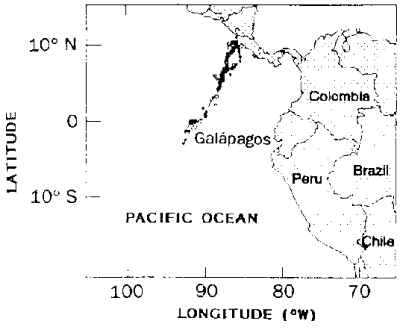 |
Science Frontiers ONLINE No. 112: Jul-Aug 1997 |
|
|
Sea turtles: from one end to the other
Leatherback turtles are mysterious in several ways: flexible shell, warmbloodedness, etc. (See SF#76 for more.) Now, we add two more remarkable capabilities to their dossier.
Precision navigation. The oily, flexible shells of leatherbacks have made it difficult for researchers to attach radio transmitters to the animals. Their very deep dives (over 1,000 meters) are also inimical to human instrumentation. But S.J. Morreale's group at Cornell have succeeded in attaching pressure-resistant transmitters to the shells on short tethers. This team was able to track female leatherbacks as they left their nesting beach in Costa Rica and headed southward, past the Galapagos, out into the open South Pacific. Surprisingly, all the leatherbacks plied a very narrow corridor each year of the experiment (1992-1995). In fact, the paths were almost for at least 2,700 kilometers southwest of the Galapagos. Highprecision navigation equipment is required here. Among the leatherbacks' "instruments" are probably sensors that detect the angle of the geomagnetic field, the length of daylight, and the identities of the oceanic currents encountered. There are probably other sensors and, of course, a brain to process all the signals; but virtually nothing is known about them.
(Morreale, Stephen J., et al; "Migration Corridor for Sea Turtles," Nature, 384: 320, 1996. Also: Monastersky, R.; "Do Sea Turtles Stop and Ask for Directions?" Science News, 150:342, 1996.)
Rectal gills. Sea turtles are airbreathers that make long, deep dives. To descend deep for long periods, they have evolved a diving adaptation radically different from that employed by the dolphins, whales, and seals; namely, rectal gills. They breathe air at the front end and water at the rear. Water is pulled in through the rectum and directed to sacs lined with blood vessels. These function like fish gills by extracting oxygen from the seawater. The oxygen-depleted water is them expelled and another "breath" is taken.
(Green, John; ISC Newsletter, 11:10, no. 3, 1991. Actual publication date: 1997. ISC = International Society of Cryptozoology.)
 | Routes taken by migrating leatherback turtles in 1992. |